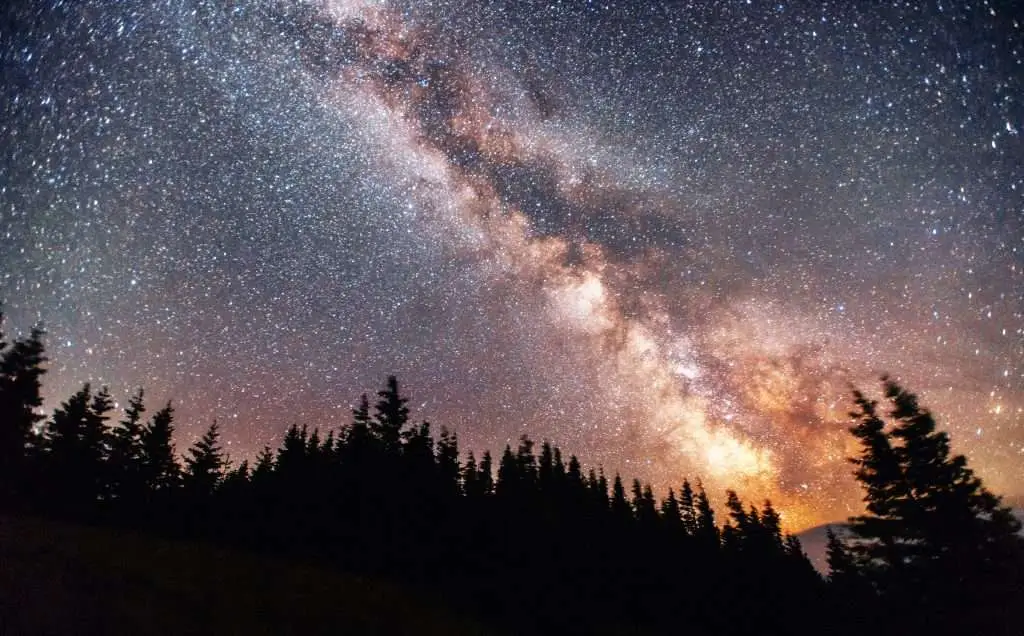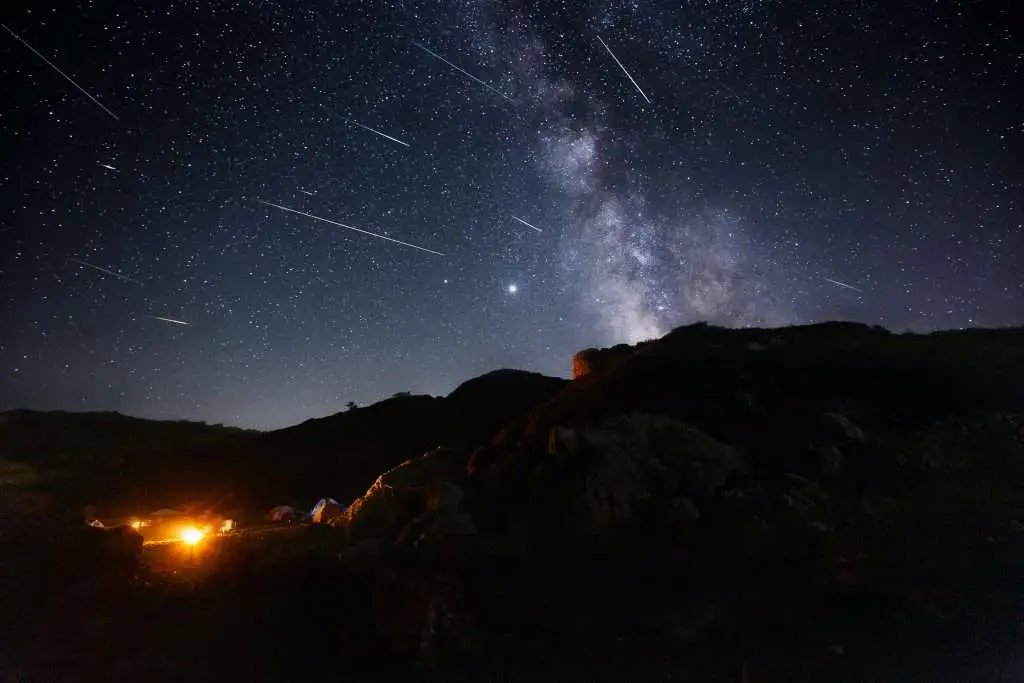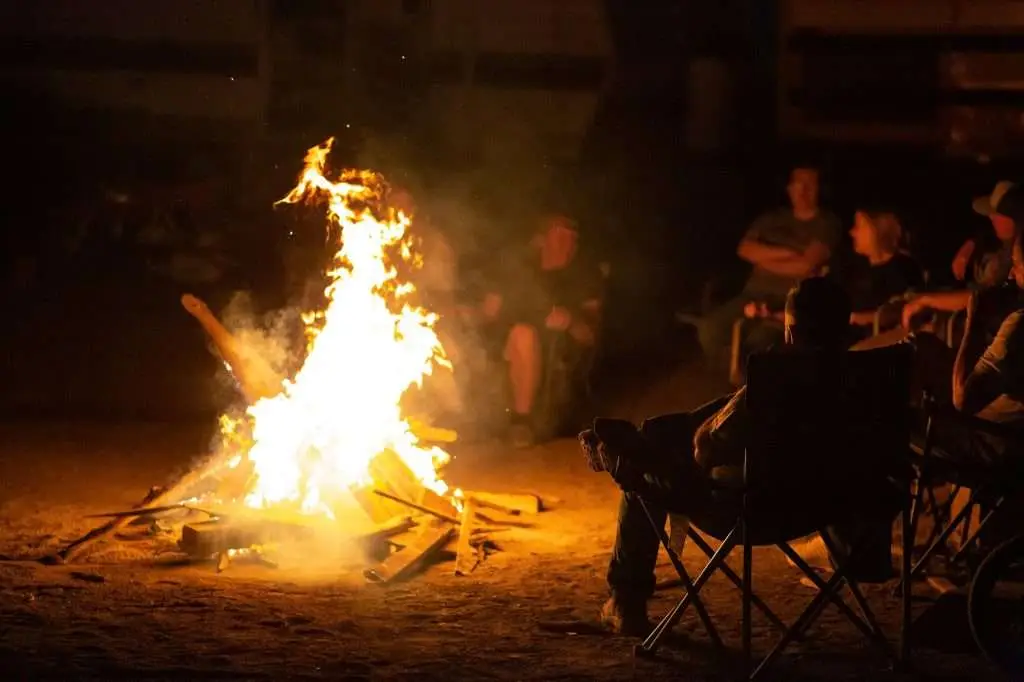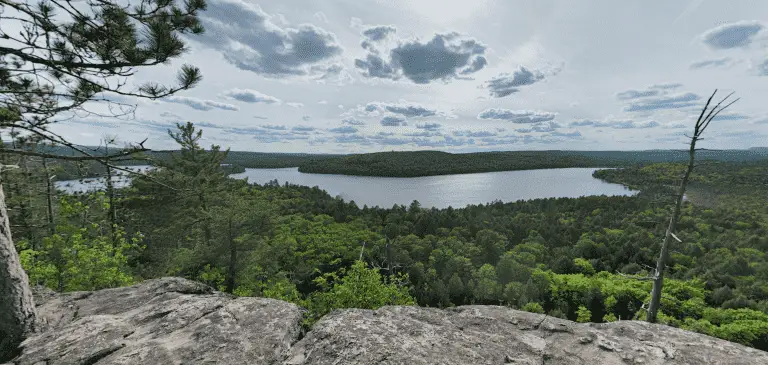Discover top star gazing Ontario locations for meteor showers and constellations. Ideal for astronomy fans and families seeking magical night skies.
What is Star Gazing Ontario?
Star gazing: a popular past-time shared by countless civilizations throughout the generations. Star gazing in Ontario is one of the most popular reasons our rural township of South Algonquin fills up during the fall and summer months, as people flock out of the city to escape light pollution, yearning for a vivid glimpse of those diamonds in the sky.
Star gazing (otherwise known as astronomy) has been a method of understanding ourselves, as well as a source of profound mystery to scientists and philosophers and amateur astronomers alike.
Star gazing is a recreational and educational hobby that can be enjoyed from almost anywhere with the naked eye, binoculars, or telescopes. Stargazing allows individuals to witness the beauty and vastness of the universe, including constellations, planets, meteor showers, comets, and the Milky Way, among other astronomical phenomena.
Star gazing is an activity best experienced away from the bright lights of cities and towns. Rural, dark skies allow for clearer and more profound celestial viewing. Stargazing is not only a way to connect with the cosmos but also offers moments of reflection, relaxation, and wonder at the universe’s complexity and scale. It’s popular among all age groups and can be a solitary activity or a shared experience with others.
What Are Meteor Showers?
Meteor showers are a stunning natural phenomenon that occur when Earth passes through the debris trail of a comet or asteroid. Each year, there are 11 major meteor showers that are worth checking out. These meteor showers occur on specific dates and are named after the constellation from which the meteors seem to originate.
At Algonquin Accommodations, visitors have the perfect opportunity to witness these spectacular meteor showers. Our location offers a dark sky-friendly area that allows for a clear and unobstructed view of the night sky. Our cozy accommodations are located close to fire pits, making it easy for visitors to sit back, relax, and watch the meteor shower with family and friends.
During a meteor shower, you can expect to see multiple shooting stars or meteors per hour. It’s a breathtaking sight that reminds us of the vastness and beauty of our universe.
Table of Contents
2025 Meteor Shower Calendar: Peak Viewing Dates for Star Gazing Ontario
- Quadrantids Meteor Shower – Peaks on January 3/4
- April Lyrids Meteor Shower – Peaks on April 22
- Eta-Aquarids Meteor Shower – Peaks on May 5/6
- June Lyrids Meteor Shower – Peaks on June 15/16
- Southern Delta Aquarids Meteor Shower – Peaks on July 28/29
- Perseids Meteor Shower – Peaks on August 12/13
- Orionids Meteor Shower – Peaks on October 21
- Taurids Meteor Showers – Occur between November 4 to 7
- Leonids Meteor Shower – Peaks around November 17/18
- Geminids Meteor Shower – Peaks on December 13/14
- Ursids Meteor Shower – Peaks on December 22
Best Times to Witness 2025's Meteor Showers
The Quadrantids Meteor Shower (January 3/4)
The year starts off with a bang, as the Quadrantids Meteor Shower peaks on January 3 and 4. It is one of the most active and reliable meteor showers of the year, with the potential to produce up to 120 meteors per hour. Named after the obsolete constellation Quadrans Muralis, this meteor shower is one of the best opportunities to witness nature’s fireworks display.
The April Lyrids Meteor Shower (April 22)
Next up, we have the April Lyrids Meteor Shower, which is set to peak on April 22. While this meteor shower is known for producing relatively few meteors, with rates of around 10-20 per hour, the Lyrids are famous for their bright fireballs that light up the night sky. Originating from the debris of comet C/1861 G1 Thatcher, the Lyrids are a sight to behold.
The Eta-Aquarids Meteor Shower (May 5/6)
In May, we have the Eta-Aquarids Meteor Shower, which is set to peak on May 5 and 6. Produced by the debris of Halley’s Comet, this meteor shower is known for producing fast and bright meteors, with rates of up to 60 per hour. If you’re lucky, you might even catch a glimpse of a “shooting star” that leaves a long-lasting trail across the sky.
The June Lyrids Meteor Shower (June 15/16)
June brings us the June Lyrids Meteor Shower, which is set to peak on June 15 and 16. While this meteor shower is not as well-known as some of the others on this list, it is still worth checking out. With rates of up to 20 meteors per hour, the June Lyrids produce bright and slow-moving meteors that are a sight to see.
The Southern Delta Aquarids Meteor Shower (July 28/29)
In late July, we have the Southern Delta Aquarids Meteor Shower, which is set to peak on July 28 and 29. Produced by the debris of the Marsden and Kracht comets, this meteor shower produces faint but steady meteors, with rates of up to 20 per hour. While the meteors may not be as bright as some of the others on this list, they are still worth checking out.
The Perseids Meteor Shower (August 12/13)
One of the most famous meteor showers of the year, the Perseids Meteor Shower, is set to peak on August 12 and 13. Produced by the debris of the comet Swift-Tuttle, the Perseids are known for producing fast and bright meteors, with rates of up to 100 per hour. The best part? The Perseids are known for producing some of the most stunning fireballs of any meteor shower.
The Orionids Meteor Shower (October 21)
The Orionids Meteor Shower is an annual event that takes place in late October, with its peak occurring around the 21st. Named for the Orion constellation from which the meteors appear to originate, the shower typically produces around 20 meteors per hour. While not the most prolific shower of the year, the Orionids are known for their bright and fast-moving meteors, making for a truly breathtaking display.
The Taurids Meteor Showers (November 4 to 7)
The Taurids are actually two separate meteor showers – the South Taurids and the North Taurids – which occur at different times but overlap to create a longer period of activity. The South Taurids generally peak around November 4th, while the North Taurids peak a few days later around November 7th. While both showers are relatively low in numbers, they are known for producing some of the year’s brightest and most spectacular fireballs.
The Leonids Meteor Shower (November 17/18)
The Leonids Meteor Shower is an annual event that takes place in November, with its peak occurring around November 17th or 18th. Named for the Leo constellation from which the meteors appear to originate, the shower has been known to produce some of the most impressive displays in history. In 1966, for example, the Leonids produced an incredible 40-50 meteors per second at their peak. While the shower is less active today, it’s still worth watching out for, with peak rates typically around 10-15 meteors per hour.
The Geminids Meteor Shower (December 13/14)
The Geminids Meteor Shower is an annual event that takes place in December, with its peak occurring around December 13th or 14th. Named for the Gemini constellation from which the meteors appear to originate, the shower is one of the most reliable and active of the year, producing around 120 meteors per hour at its peak. The Geminids are known for their colorful and long-lasting trails, making for a truly mesmerizing spectacle.
The Ursids Meteor Shower (December 22)
The Ursids Meteor Shower is an annual event that takes place in December, with its peak occurring around December 22nd. Named for the Ursa Minor constellation from which the meteors appear to originate, the shower is relatively minor, with peak rates typically around 5-10 meteors per hour. However, the Ursids are known for their slow-moving meteors and bright fireballs, making them a worthwhile spectacle for dedicated stargazers.
Where to Stay when Star Gazing Ontario?
Discover South Algonquin’s serenity with Algonquin Accommodations, your choice for clean, affordable retreats. Choose from 3 motels, an inn, or a nature-immersed campground. Enjoy complimentary access to bikes, canoes, kayaks, paddle boards, and snowshoes.
Algonquin Accommodations offers prime stargazing with minimal light pollution. View meteor showers, the Milky Way, and constellations in crystal clarity. It’s more than a stay; it’s a celestial event viewing spot.
For night sky lovers, our properties, including Dream Catcher Motel, Bellwood Inn, East Gate Motel, and riverside Rolling Rapids Motel, provide the perfect backdrop for the year’s best meteor showers.
You can get gorgeous views of the night skies from Algonquin Park campgrounds (weather permitting). Cozy up outside your tent and enjoy the night sky beside the cooling embers of an extinguished campfire before you tuck into bed. Book a site at our Wilderness Campground and enjoy the heavens with us.
See Also: The top 5 motels to visit in Whitney, Ontario – Algonquin Accommodations
Best Spots to watch?
South Algonquin is a prime destination for observing the spectacular meteor showers as well as the best star gazing Ontario, boasting dark skies and stunning landscapes. Its numerous remote locations, far from the glare of city lights, offer unmatched views of celestial phenomena. Stargazing is a cornerstone of tourism in South Algonquin. Below are the top spots within South Algonquin for meteor shower enjoyment, each providing a distinct and memorable viewing experience:
 Dream Catcher Motel & Bellwood Inn Backyard: This cozy spot blends comfort with breathtaking night sky vistas. Perfect for luxury stargazers. MORE
Dream Catcher Motel & Bellwood Inn Backyard: This cozy spot blends comfort with breathtaking night sky vistas. Perfect for luxury stargazers. MORE- Bellwood Forest: Just a short walk from Bellwood Inn and Dream Catcher Motel, this rugged trail leads to a forest clearing atop a hill, offering night sky views above the treetops.
- Airy Road Trussell Bridge: A historical bridge providing a unique perspective over water, with meteor showers reflecting below for a mesmerizing display.
- Wilderness Campground: Ideal for camping enthusiasts, this site offers a night under the stars filled with meteor sightings. MORE
- Four Corners Algonquin Glamping: Comfort meets rustic in this glamping experience, enhanced by stargazing events with expert speakers. MORE
- Second Iron Bridge on the Old Rail Trail: Offers wide sky panoramas and an optional hillside vantage point for photographers and height-seekers. MORE
- Poverty Lake: Experience the night sky’s reflection over calm waters, doubling the beauty of meteor showers.
- Look Out Trail Lookout: Ascend for an elevated view, where the sky opens up for a broad, unobstructed meteor display against Algonquin’s wilderness.
- Rolling Rapids Motel: Offers rooms with a view and a riverside location, combining the serene river sounds with spectacular meteor watching steps away. MORE
Don’t miss out on the chance to see these beautiful meteor showers this year. For an even better time, enjoy the meteor show with a camp fire. Camp fires are available at all of our locations. Hands down, we offer the most comfortable and best viewing experiences at Algonquin Accommodations!
For more information, visit the American Meteor Society website at https://www.amsmeteors.org/meteor-showers/meteor-shower-calendar/.












 Dream Catcher Motel & Bellwood Inn Backyard: This cozy spot blends comfort with breathtaking night sky vistas. Perfect for luxury stargazers.
Dream Catcher Motel & Bellwood Inn Backyard: This cozy spot blends comfort with breathtaking night sky vistas. Perfect for luxury stargazers. 


